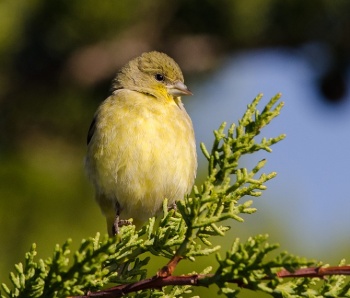Alternative name: Dark-backed Goldfinch, Arkansas Goldfinch[2]
- Spinus psaltria
Carduelis psaltria, Astragalinus psaltria[2]
Identification
10cm
- Yellow underparts
- White patches on wings at base of primaries are diagnostic
- Black upperparts
- Long conical bill
- Undertail has broad black tip
Females: olive-green upperparts, yellow-buff underparts
Similar Species
American Goldfinch lacks the black terminal band on the underside of the tail.
Distribution
Southwestern United States through Mexico and Central America to Colombia, Venezuela, Ecuador, and Peru in South America.
Northern populations migratory, southernmost US and the rest are residents year round. Casual vagrant east to the Mississippi and Missouri rivers.
Taxonomy
Formerly included in genus Carduelis.
Subspecies[1]
Five subspecies are recognized:
- S. p. hesperophilus:
- Western US to southern Baja California and north-western Mexico
- S. p. witti:
- Tres Marías Islands (off western Mexico)
- S. p. psaltria:
- S. p. jouyi:
- South-eastern Mexico (Yucatán Peninsula and northern Quintana Roo)
- S. p. columbianus:
Habitat
Open habitats with scattered trees and brush, especially near water. Common near human dwellings; comes readily to feeders, especially for thistle seed.
Behaviour
Diet
The diet includes tree buds and weed seeds. Favors thistle seed and sunflowers.
Breeding
They build a cup-shaped nest of plant material in a bush or tree and 3-4 blue-white eggs are laid.
References
- Clements, JF. 2009. The Clements Checklist of Birds of the World. 6th ed., with updates to December 2009. Ithaca: Cornell Univ. Press. ISBN 978-0801445019.
- Avibase
- Wikipedia
Recommended Citation
- BirdForum Opus contributors. (2024) Lesser Goldfinch. In: BirdForum, the forum for wild birds and birding. Retrieved 18 April 2024 from https://www.birdforum.net/opus/Lesser_Goldfinch





